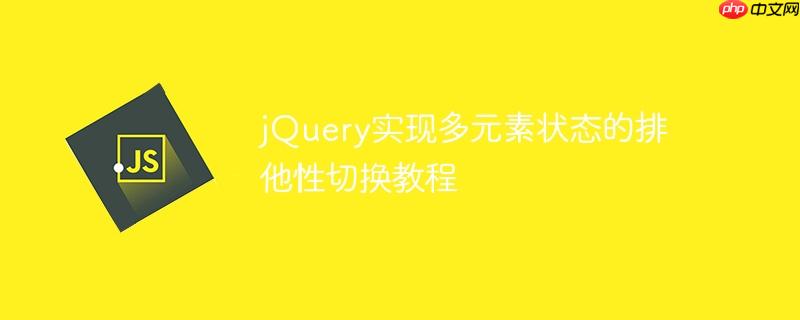
在前端开发中,我们经常会遇到需要管理多个相似交互元素状态的场景,例如手风琴菜单、选项卡、或者像本例中的可变形按钮组。一个常见的需求是,当用户点击其中一个元素使其进入“激活”状态时,其他所有同类元素应自动返回到“非激活”或“初始”状态。这种“点击一个,关闭其他”的排他性逻辑对于维护用户界面的清晰性和一致性至关重要,尤其是在滑块(slider)等复杂组件中,可以避免出现多个元素同时处于激活状态的混乱情况。
最初的实现可能只关注当前点击元素的自身状态切换,而忽略了对其他同类元素的影响。例如,以下代码仅切换当前点击按钮的类:
$('body').on('click', '.icon_product', function () {
if (this.classList.contains("icon_product")) {
$(this).toggleClass("change_icon-product");
} else {
// 这里的逻辑在toggleClass存在时可能不会被触发,且存在冗余
$(this).removeClass("change_icon-product");
}
});这段代码的问题在于,它无法实现排他性:当一个按钮被激活后,再次点击另一个按钮,前一个按钮的状态并不会被重置。为了解决这个问题,我们需要扩展其功能,使其在切换当前元素状态的同时,能够识别并重置其他所有同类元素的状态。
为了实现按钮的视觉变化,我们使用CSS来定义两种状态:默认状态和激活状态。这里以一个由两条线构成的图标为例,通过CSS transform 属性使其在点击时从平行线变为“X”形。
/* 基础样式 */
.icon_product {
display: block;
cursor: pointer;
position: relative;
padding: 15px;
margin-top: 0px;
}
/* 图标线条基础样式 */
.icon-line1_product,
.icon-line2_product {
width: 35px;
height: 5px;
background-color: #f00;
margin: 6px 0;
border-radius: 10px;
transition: all 0.6s ease-in-out; /* 平滑过渡效果 */
-webkit-transition: all 0.6s ease-in-out;
-moz-transition: all 0.6s ease-in-out;
-o-transition: all 0.6s ease-in-out;
-ms-transition: all 0.6s ease-in-out;
}
/* 第二条线在默认状态下的初始旋转,使其与第一条线重叠,形成一个垂直偏移 */
.icon-line2_product {
transform: rotate(90deg) translate(-11px, 0px);
-webkit-transform: rotate(90deg) translate(-11px, 0px);
-moz-transform: rotate(90deg) translate(-11px, 0px);
-o-transform: rotate(90deg) translate(-11px, 0px);
-ms-transform: rotate(90deg) translate(-11px, 0px);
}
/* 激活状态(.change_icon-product 类存在时)下的线条样式 */
.change_icon-product .icon-line1_product {
transform: rotate(45deg) translate(8px, 0px); /* 第一条线旋转45度 */
-webkit-transform: rotate(45deg) translate(8px, 0px);
-moz-transform: rotate(45deg) translate(8px, 0px);
-o-transform: rotate(45deg) translate(8px, 0px);
-ms-transform: rotate(45deg) translate(8px, 0px);
}
.change_icon-product .icon-line2_product {
transform: rotate(-45deg) translate(8px, 0px); /* 第二条线旋转-45度 */
-webkit-transform: rotate(-45deg) translate(8px, 0px);
-moz-transform: rotate(-45deg) translate(8px, 0px);
-o-transform: rotate(-45deg) translate(8px, 0px);
-ms-transform: rotate(-45deg) translate(8px, 0px);
}当 .icon_product 元素被添加或移除 change_icon-product 类时,其内部的线条会根据上述CSS规则进行平滑的变形。
为了演示多元素交互,我们需要在页面中放置多个可变形按钮。每个按钮都被包裹在一个独立的容器中。
<section>
<div id="main-content_product">
<div class="icon_product">
<div class="icon-line1_product test"></div>
<div class="icon-line2_product test"></div>
</div>
</div>
<div id="main-content_product">
<div class="icon_product">
<div class="icon-line1_product test"></div>
<div class="icon-line2_product test"></div>
</div>
</div>
<div id="main-content_product">
<div class="icon_product">
<div class="icon-line1_product test"></div>
<div class="icon-line2_product test"></div>
</div>
</div>
<div id="main-content_product">
<div class="icon_product">
<div class="icon-line1_product test"></div>
<div class="icon-line2_product test"></div>
</div>
</div>
</section>在这个结构中,每个 .icon_product 按钮都位于一个 div 容器(带有 id="main-content_product")内部。这些容器彼此是兄弟元素,这一层级关系对于后续的jQuery选择器至关重要。
要实现点击一个按钮时,其他所有按钮恢复到初始状态,我们需要在点击事件处理函数中加入额外的逻辑来选择并操作其他元素。
<script src="https://cdnjs.cloudflare.com/ajax/libs/jquery/3.3.1/jquery.min.js"></script>
<script>
$('body').on('click', '.icon_product', function() {
// 1. 切换当前点击按钮的激活状态
$(this).toggleClass("change_icon-product");
// 2. 将所有其他同类按钮恢复到初始(非激活)状态
$(this).parent() // 获取当前点击按钮的父元素(即 id="main-content_product" 的div)
.siblings() // 获取这个父元素的所有同级元素
.find('.icon_product') // 在这些同级元素内部查找所有 class="icon_product" 的按钮
.removeClass("change_icon-product"); // 移除它们的激活类
});
</script>代码解析:
$(this).toggleClass("change_icon-product");
$(this).parent().siblings().find('.icon_product').removeClass("change_icon-product");
通过这一行简洁的jQuery代码,我们实现了多元素状态的排他性切换,确保每次只有一个按钮处于激活状态。
将HTML、CSS和jQuery代码整合在一起,即可得到一个完整的工作示例。
<!DOCTYPE html>
<html lang="en">
<head>
<meta charset="UTF-8">
<meta name="viewport" content="width=device-width, initial-scale=1.0">
<title>多元素排他性状态切换</title>
<script src="https://cdnjs.cloudflare.com/ajax/libs/jquery/3.3.1/jquery.min.js"></script>
<style>
body {
font-family: Arial, sans-serif;
display: flex;
justify-content: center;
align-items: center;
min-height: 100vh;
margin: 0;
background-color: #f4f4f4;
}
section {
display: flex;
gap: 20px; /* 按钮之间的间距 */
flex-wrap: wrap; /* 允许换行 */
justify-content: center;
}
/* 基础样式 */
.icon_product {
display: block;
cursor: pointer;
position: relative;
padding: 15px;
margin-top: 0px;
border: 1px solid #ccc;
border-radius: 5px;
background-color: #fff;
box-shadow: 0 2px 5px rgba(0,0,0,0.1);
}
/* 图标线条基础样式 */
.icon-line1_product,
.icon-line2_product {
width: 35px;
height: 5px;
background-color: #f00;
margin: 6px 0;
border-radius: 10px;
transition: all 0.6s ease-in-out; /* 平滑过渡效果 */
-webkit-transition: all 0.6s ease-in-out;
-moz-transition: all 0.6s ease-in-out;
-o-transition: all 0.6s ease-in-out;
-ms-transition: all 0.6s ease-in-out;
}
/* 第二条线在默认状态下的初始旋转,使其与第一条线重叠,形成一个垂直偏移 */
.icon-line2_product {
transform: rotate(90deg) translate(-11px, 0px);
-webkit-transform: rotate(90deg) translate(-11px, 0px);
-moz-transform: rotate(90deg) translate(-11px, 0px);
-o-transform: rotate(90deg) translate(-11px, 0px);
-ms-transform: rotate(90deg) translate(-11px, 0px);
}
/* 激活状态(.change_icon-product 类存在时)下的线条样式 */
.change_icon-product .icon-line1_product {
transform: rotate(45deg) translate(8px, 0px); /* 第一条线旋转45度 */
-webkit-transform: rotate(45deg) translate(8px, 0px);
-moz-transform: rotate(45deg) translate(8px, 0px);
-o-transform: rotate(45deg) translate(8px, 0px);
-ms-transform: rotate(45deg) translate(8px, 0px);
}
.change_icon-product .icon-line2_product {
transform: rotate(-45deg) translate(8px, 0px); /* 第二条线旋转-45度 */
-webkit-transform: rotate(-45deg) translate(8px, 0px);
-moz-transform: rotate(-45deg) translate(8px, 0px);
-o-transform: rotate(-45deg) translate(8px, 0px);
-ms-transform: rotate(-45deg) translate(8px, 0px);
}
</style>
</head>
<body>
<section>
<div id="main-content_product">
<div class="icon_product">
<div class="icon-line1_product test"></div>
<div class="icon-line2_product test"></div>
</div>
</div>
<div id="main-content_product">
<div class="icon_product">
<div class="icon-line1_product test"></div>
<div class="icon-line2_product test"></div>
</div>
</div>
<div id="main-content_product">
<div class="icon_product">
<div class="icon-line1_product test"></div>
<div class="icon-line2_product test"></div>
</div>
</div>
<div id="main-content_product">
<div class="icon_product">
<div class="icon-line1_product test"></div>
<div class="icon-line2_product test"></div>
</div>
</div>
</section>
<script>
$('body').on('click', '.icon_product', function() {
$(this).toggleClass("change_icon-product");
$(this).parent().siblings().find('.icon_product').removeClass("change_icon-product");
});
</script>
</body>
</html>本教程详细介绍了如何利用jQuery的 toggleClass()、parent()、siblings() 和 find() 方法,结合CSS样式,实现多元素排他性状态切换的交互逻辑。这种模式在前端开发中非常实用,能够有效管理复杂的用户界面状态,确保良好的用户体验。理解并灵活运用这些jQuery方法,是构建动态和响应式Web应用的关键技能之一。在实际应用中,务必注意HTML结构的规范性,并根据具体需求选择最合适的DOM操作策略。
以上就是jQuery实现多元素状态的排他性切换教程的详细内容,更多请关注php中文网其它相关文章!

每个人都需要一台速度更快、更稳定的 PC。随着时间的推移,垃圾文件、旧注册表数据和不必要的后台进程会占用资源并降低性能。幸运的是,许多工具可以让 Windows 保持平稳运行。

Copyright 2014-2025 https://www.php.cn/ All Rights Reserved | php.cn | 湘ICP备2023035733号